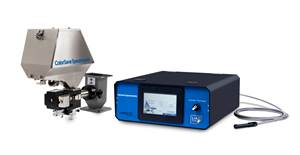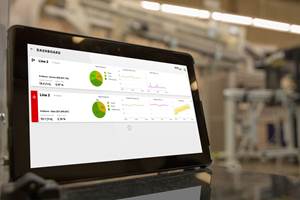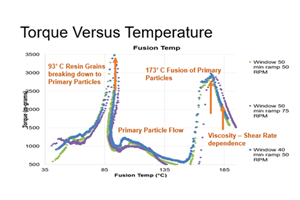How to Improve Quality with Offline Inspection and Analysis
Automated sample testing with a light table detects the smallest contamination in flakes, micro granulates and sample test sheets.
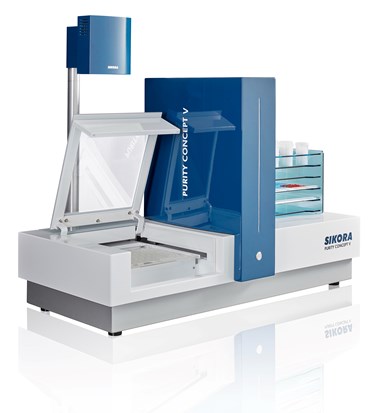
SIKORA’s new automated light table system for enhanced offline inspection and analysis of plastic samples. (Photos: SIKORA International Corp.)
Quality requirements for manufacturing and processing of plastics are continuously increasing and becoming more complex. In addition to continuous online monitoring of the production process by pellet inspection and sorting systems, periodic offline sample testing of material is required in order to ensure consistent quality from the raw material to the final product.
Manual light tables, or early versions of automated visual inspection devices, were accepted standards in the plastics industry. However, these methods posed challenges for the operator, as the quality of their inspection was determined by their focus and vision.
A technology developed to combat these challenges combines the advantages of manual visual inspection with an automated material sample control. The automatic light table system automatically detects and visually displays contamination from 2 mil (50 μm) size and evaluates it statistically. The contamination is clearly identified and located, and follow-up inspections are possible at any time. The system is more precise, faster, reproducible and reliable than the previously accepted standards. As such, it has been shown to contribute significantly to quality control and efficient process optimization.
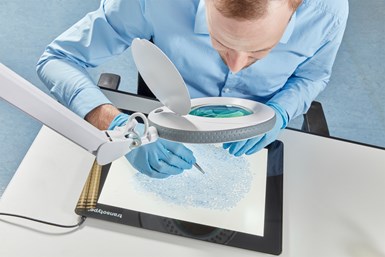
Operator manually inspects pellets on a light table.
Moreover, the system offers a broad range of applications. Flakes, micro granulates and sample test sheets can be inspected on the sample tray. The tray has a width of 11.6 × 8.3 in. (295 × 210 mm). Approximately 0.22 lb (100 g) of pellets can be inspected and analyzed per run, which corresponds to up to 3300 pellets with a size of 0.16 × 0.16 × 0.16 in. (4 × 4 × 4 mm). In addition to its analysis potential for determining root causes and process control in laboratory settings, the system is suitable for incoming goods inspection due to its quick (within seconds) automatic analysis, as well as for outgoing goods in order to compare the quality with customer requirements
Meeting Challenges of Quality Standards
Quality standards in the plastics industry present great challenges for manufacturers and processors. Inspecting and analyzing raw material before it enters the production process is an industry standard, designed to protect the end-user from any contaminants that can compromise the integrity of the final product.
To ensure the highest quality of their materials, some plastic manufacturers use online inspection and sorting systems. The online systems inspect the material, detect contaminants, colored anomalies and inhomogeneities in the ongoing production process, and they will then automatically sort out contaminated material. The online systems have optical and possibly X-ray abilities to find and sort out contaminated product.
Offline inspection and analysis provide material manufacturers and processors with key information on contamination, the causes of contaminants as well as on their own production process.
Additionally, systems for periodic sample testing, incoming goods inspection and analysis of plastic material are often used. This offline inspection and analysis provide material manufacturers and processors with key information on plastic contamination and the causes of contaminants, as well as on their own production processes. Therefore, optical testing is essential for advanced production lines processing plastics.

Color camera image of pellets show marked contaminants with selected pellets highlighted in color and zoomed-in.
Plastics, as they are used in the medical sector, aerospace or automotive industries, require very high quality standards as well as reliable control and processing. Contamination may occur during different steps of the plastic product production process.
During pellet extrusion, for example, black specks can occur in the material due to temperature peaks. If the contaminated pellets enter the production process, the absolute purity of the final product is no longer guaranteed — sometimes with severe consequences. During the production of medical tubing, contaminants in the raw material can lead to a full loss of production. Before production may start again, the whole production line must be shut down, cleaned and restarted. The purity of the plastic pellets is also critical in injection molding plants. Contaminated material can clog hot runners, which has the potential to necessitate the mold being shut down, removed and cleaned.
Manual Light Tables & Automated Optical Inspection Systems
Established technologies for sample testing, inspection and analysis of plastic material include manual light tables and automated optical inspection systems.
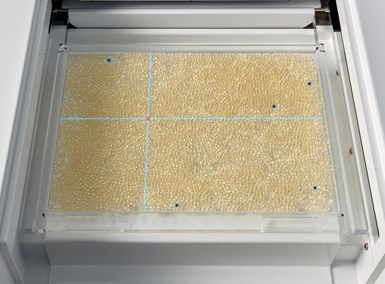
Detected contamination is highlighted in color. Pellets that are selected on the monitor are visualized on the sample tray by crosshairs.
Manual light tables are commonly used in the industry for visual sample testing and incoming goods inspection of plastic material. The material to be inspected is illuminated from under a clear table and manually inspected for contamination by an operator. This time-consuming method can take anywhere from 10 min to over 30 min, depending on what the pellets are being inspected for.
The accuracy of locating and discarding contaminated pellets depends on the individual operator. A person’s ability to find contaminated pellets on a light table could be limited due to factors such as personal feelings, experience, and available time on that particular day, which can influence the results and repeatability of the test. Reflective and highly transparent pellets further complicate manual visual inspection, because contamination in the pellets can be difficult to see. Additional limits include the detectable sizes of contamination for the human eye as well as their classification into size classes.
Alternative offline optical inspection devices available on the market feed the sample material through a hopper and channel it into an inspection area while pictures of the contaminated material are taken successively. Direct comparisons of the contaminated pellets to the pictures taken, as well as a follow-up inspection, are not possible. These alternative optical systems are designed differently from the newly developed automated light table and do not have a method or software capabilities to match up the pictures with the actual contaminated pellets.
During production of medical tubing, contaminants in the raw material can lead to a full loss of production.
As such, the user would have pictures of the contaminated pellets but not the pellets themselves to review. In contrast, after examination of the pellets, the automatic light table will have a picture of each contaminated pellet that can be directly correlated to the contaminated pellet. That individual pellet can be removed from the tray and inspected further as needed. This ability with the automated light table will give the user the possibility of finding the root cause of the contamination.
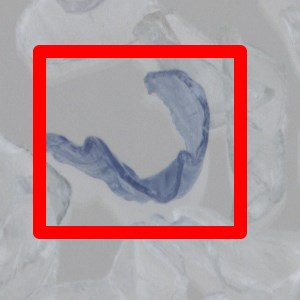
Examples of discoloration in flakes detected by optical technology.
How it Works
The combination of a visual light table and automatic sample testing, better known as an automated optical inspection system, allows for direct comparison and follow-up inspection of the contaminated pellets. The operator places the test material on a sample tray. The automatic light table transports the tray with the material through the inspection area, which is equipped with a CMOS line-scan color camera.
The inspection takes place automatically and within seconds. The automatic optical inspection system contains a projector that illuminates the contaminated material directly on the sample tray. Simultaneously, it is displayed and marked on the monitor, including information on the size and area of the contamination. By analyzing the images, contaminants such as black specks and discoloration, starting from 2 mil (50 μm) size, are automatically detected, visualized and analyzed. The system can be used with transparent, translucent or colored/opaque material. A recent user of the new system said, “Our operators are very pleased that the system has reduced their eyestrain and eliminated the uncomfortable position of looming hunched over the light table. The standardized method of inspection with the system brings us confidence that nothing is being overlooked.”
The automatic optical inspection and analysis system contains software for detection, visualization and evaluation of contamination. The software includes an image gallery of detected contaminations, as well as statistics regarding their size, area and number. Furthermore, previously inspected material can be imported for follow-up analysis or compared with other prior sample tests with regards to amount of contamination or color deviations.
The inspection and analysis system can be integrated into the company network via a LAN interface to export and process collected data. The data provides the users with comprehensive information about the process and the material quality. For example, by establishing a central and constantly updating database, conclusions regarding sources and causes of contamination are possible. On this basis, existing processes in the company or at suppliers can be optimized to ensure a comprehensive quality control. These automated systems are appearing in manufacturing facilities, compounding plants and at recyclers. They give the operators in these industries a quick look at the quality of their pellets.

Black speck in a pellet is one type of contamination example detected by optical technology.
Another similar automated system allows the user to detect metallic contamination inside of non-transparent, colored and transparent plastic material. During production of the plastic pellets, chips or flakes of metal can become imbedded in the pellets. This metal contamination can present major difficulties within the medical, electronics and automotive industries.
Like a medical X-ray, this system sends an X-ray through the pellets to find any metallic contamination inside the pellet. The pellet material and the metal absorb the X-rays at different levels. The metallic contamination embedded into the pellet absorbs more X-rays than the plastic material surrounding it. The X-ray receiver measures the amount of X-rays absorbed by the material and the metallic contaminant. The system’s software can analyze and determine that a metallic particle is present in the pellet. Individual metal-contaminated pellets can be removed from the sample tray and magnified offline for a closer look. At the same time, they are marked by pointing system with lighted crosshairs on the sample tray. A clear allocation of the contamination and follow-up inspection are always possible and allow for new insights regarding quality assurance, quality control and the production process.
ABOUT THE AUTHOR: Alexander “Alex” Nguyen is a business development engineer for SIKORA International Corp., a sub. of SIKORA AG. Alex is responsible for sales of pellet inspection equipment for the plastics industry and services plastics customers across the U.S. and Canada. Alex has eight years of experience in industrial manufacturing and received a Bachelor of Science in Biochemistry and Engineering from Wayne State University in Michigan. Contact: 770-486-1233; sales@sikora.net; sikora.net.
Related Content
Color-Measurement for Extrusion, Molding
System helps processors control the cost of quality due to color variations, using real-time color data for QC analytics and color optimization.
Read MoreHow Inline Vision Inspection Can Minimize Scrap in Molding
Once viewed by injection and blow molders as a necessary evil, machine vision technology today can continuously monitor and improve production while reducing costs.
Read MoreDatacolor Acquires Matchmycolor
The acquisition of the specialist in color formulation and communication software further expands Datacolor’s global industry presence in color management.
Read MoreTry This Alternate Method for Heating Your Torque Rheometer
Rheometers are generally not on all the time. And most users have found that the first test run in the instrument after heating up is not very reliable and is usually discarded. Try this method instead.
Read MoreRead Next
Why (and What) You Need to Dry
Other than polyolefins, almost every other polymer exhibits some level of polarity and therefore can absorb a certain amount of moisture from the atmosphere. Here’s a look at some of these materials, and what needs to be done to dry them.
Read MoreLead the Conversation, Change the Conversation
Coverage of single-use plastics can be both misleading and demoralizing. Here are 10 tips for changing the perception of the plastics industry at your company and in your community.
Read MoreProcessor Turns to AI to Help Keep Machines Humming
At captive processor McConkey, a new generation of artificial intelligence models, highlighted by ChatGPT, is helping it wade through the shortage of skilled labor and keep its production lines churning out good parts.
Read More




















.png;maxWidth=300;quality=90)

